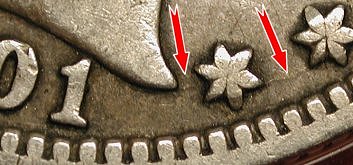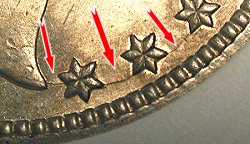 |
There were only two pairs of dies used to make this date, and they have specific date and mintmark positions.
First of all, the date and mintmark must exactly match one of the die pairs exhibited in the following sets of photos.
There are two sets of photos for both die pairs, representing higher grade and lower grade coins, as the devices tend to get "mushy" as the coins wear. There are also some other characteristics you can look for, and these are listed below as well.
This reference uses the terminology found in The Complete Guide to Barber Quarters, 2nd Edition, by David Lawrence,
one of the true Barber series experts of all time.
Only a small percentage of the Obverse A coins
seem to have this die crack, but if a coin does possess this die crack, it is most decidedly genuine. The
crack resides in a protected area, and has been seen in coins as low as the G/AG grade level. The
BCCS would be interested to hear from anyone with a coin whose die crack is more advanced than the coin
shown (via email address at the bottom of the page).
|
 |
 |
Die cracks: Obverse Die B also developed die cracks late in its
production run. In fact, a spectacular specimen was discovered with extensive cracks upwards in both directions
from the date through all of the stars on both sides (!) -- the MS62 specimen pictured here presently appears to be unique.
Only a single other example has been seen with cracks anywhere near as advanced (the MS67 specimen in the John Hugon Collection,
sold for $150,000 in the 2005 FUN Heritage sale). However, a few low grade specimens have been seen with the beginning stages
of the die cracks on the right side of the date. As with Die A above, the BCCS would like to hear from anyone with a late or terminal die state like described here.
|
|
 |
 |
In addition to the mintmark position, scrutinize the mintmark itself -- it should match the rest of the coin. If the coin is a G or VG coin, the mintmark should not look like it belongs on an XF coin! Many fakes are like this. If the coin is a VG, then the mintmark should look like a VG.
Unfortunately, one of the methods of authenticating the 1896-S cannot be used for the 1901-S.
Beginning in 1900, the mints switched to the same types of collars, resulting in identical edge reeding.
Thus, you cannot tell the 1901-S from the P and O coins by looking at the edge (like you can for the 1896-S).
Another point: examine the edge of all 1901-S coins. This writer has seen a fake that consisted of two halves of two different
coins that were joined together: a 1901-P obverse married with an "S" reverse of another year. When the unsuspecting victim
examined the mintmark, he did not see evidence of an added "S" so he thought he was safe. Nope, when the coin was removed from the 2x2, there was a nice seam around the reeded edge of the coin easily showing the fakery. The date position was wrong and would have easily given it away, if he had only known what to look for.
See also article on Counterfeit 1901-S Barber Quarters.
Sample fakes
The single best reference to Barber Quarters, is The Complete Guide to Barber Quarters, 2nd Edition, by David Lawrence (1992, DLRC Press, Virginia Beach VA).
The above detailed information and photos Copyright © 2005 Barber Coin Collectors' Society -- all rights reserved worldwide.
This page may be printed and distributed as long as Copyright notice is included.
|

